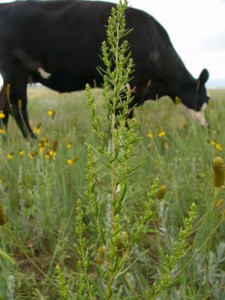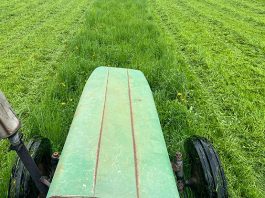

An article in the March 2012 issue of BEEF magazine describes the success that a rancher in Oklahoma has had in using herbicide to improve his pastures. Using a combination of fertilizer and herbicide treatments to combat ragweed, he describes how, with good rainfall, he harvested 4.12 bales/acre of 1,500 lb. large square bales in 2010, and then 2.18 bales/acre during drought in 2011. In those areas where he only applied herbicide in the drought year, he got 1.84 bales per acre. In 2010, the extra inputs were a wash because the cost of production was about equal to what he could have purchased hay for. The rancher didn’t run numbers for 2011, when drought increased hay costs, but felt that he was ahead because he didn’t have to purchase as much hay as he might have.
What really caught my eye was the rancher’s comments about the protein value of his hay. In 2010, the protein was 7%. But in the 2011 drought year, the areas where he used both fertilizer and herbicide produced 8.7% protein hay. Yet, in spite of the gains in protein values, he still doesn’t have enough to meet the maintenance requirements of his animals: 10.5% CP for mature beef cows and first-calf heifers, 8.8% CP for pregnant and replacement beef heifers, and 10.5% CP for all types of beef cattle.
That got me thinking about the nutritional value of ragweed, which is significantly higher than grass, and how changing our thinking about what we feed our livestock might change our management and production costs.
Virginia Cooperative Extension has a publication called “The Nutritive Value of Common Weeds and their Relation to Livestock Nutrient Requirements” (by A. Ozzie Abaye, Guillermo Scaglia, and Chris Teutsch). Their review of the literature shows that most common pasture weeds have sufficient crude protein to meet livestock requirements. They found that common ragweed had greater invitro dry matter digestibility (IVDMD) than both alfalfa an oats. It’s average invitro digestible dry matter is 73%, it’s acid detergent fiber is 25%, and it’s crude protein is 25%.
Here’s one of the tables from this article comparing the nutritive value of several common pasture weeds with Alfalfa. The two samples of ragweed and one of alfalfa are highlighted in yellow. I thought you’d enjoy the whole table though because you might have some of the other weeds listed.
In case you’ve forgotten, NDF (neutral detergent fiber) measures cell-wall material and is used to predict how much livestock may eat of the plant. The higher the number, the more fibrous the plant is, meaning animals will eat less. ADF (acid detergent fiber) is a similar cell-wall measure and is used to estimate digestibility. The higher the number the lower the plant’s digestibility. Again, if it’s not easy to digest, an animal will eat less.
What does all this mean to a rancher? Well, if it were me, I’d be comparing the protein values and the digestibility of the weeds in my pasture to the grass in my pasture and how that relates to what my livestock need to do their jobs of growing big and fat. From there I’d think about what was more cost-effective for my particular operation. Would I rather invest my time and my potential profits by buying equipment and spraying weeds? Or would I rather spend 10 hours of my time and $2.50 each to teach my cattle to turn those plants into nutritious forages?
I don’t mean to say anything negative about this particular rancher’s management. It’s clear from the article that he thinks hard about what he can do to improve his product and his margins. He just may never have thought of weeds as forage.
On of the things the rancher points out is that “Weeds grow best in drought, more so than grass.” It’s looking like drought this summer in many parts of the country. Maybe it’s time to turn those weeds into forage.





Another comment. In the wild cattle ate everything available for survival. We have so babied our cattle that they lost this natural behavior. Let a cow be a cow. She knows what to do if you let her.
Another point about cattle grazing weeds. The weeds are there taking moisture from the soil. If a cow is eating these weeds, she is in effect taking more pounds of forage production off the land. Instead of weeds being wasted, they create a greater forage base. Cattle need a diversity in their diet which contributes to their health. Weeds will always be there, so learn to love them.
Good article. This rancher produces hay tho -isn’t grazing this pasture? If he bales it, How might the drying of the ragweed affect the nutritional value? Perhaps since it started off better than alfalfa, it would retain it’s advantage. Additionally,once it goes to seed would it’s value decline dramatically and ruin his last cutting? That would be costly. Just things to ponder. I’ve hand fed my cattle young ragweed and they will nibble on it but have not taught them to eat it- guess I should try it.
Comments are closed.